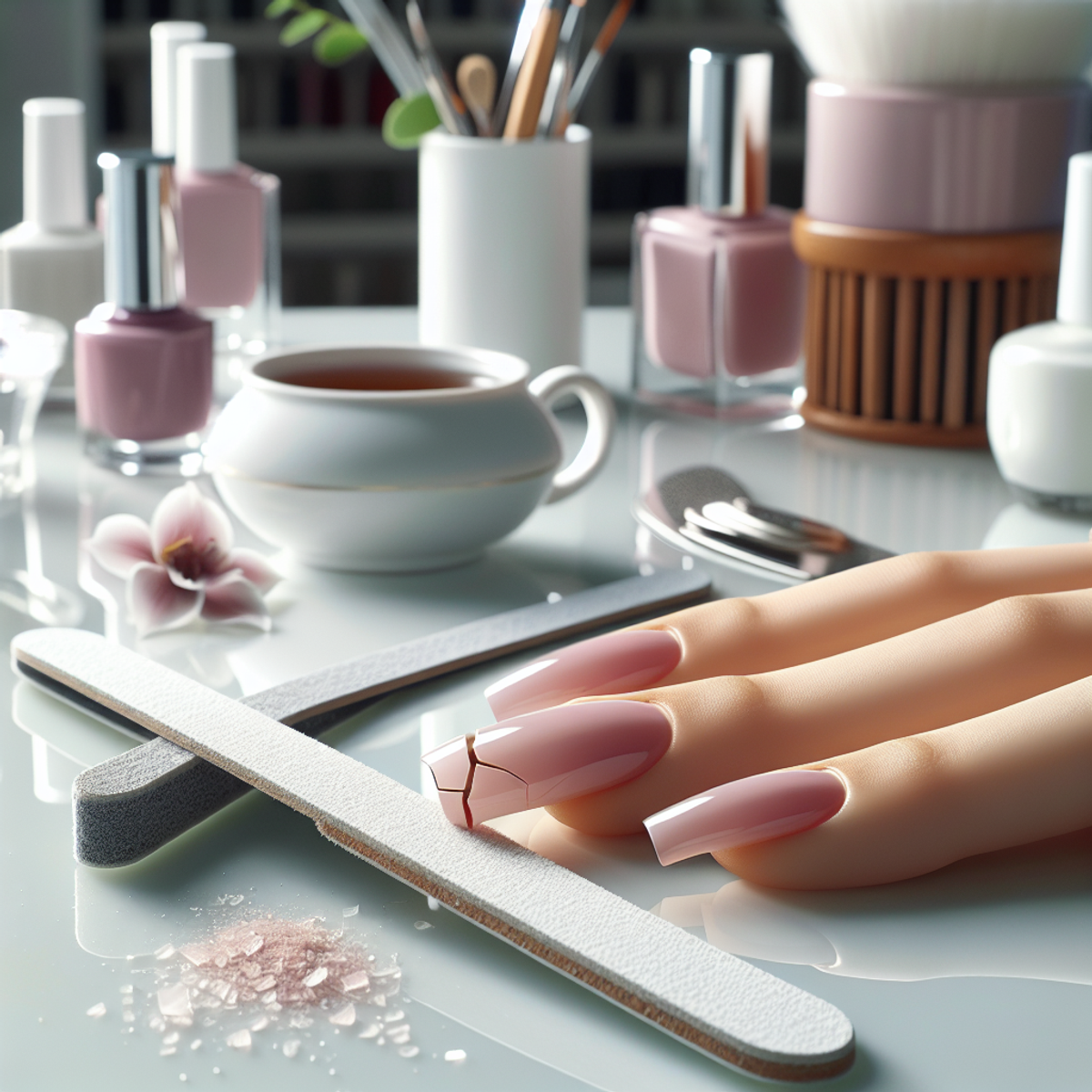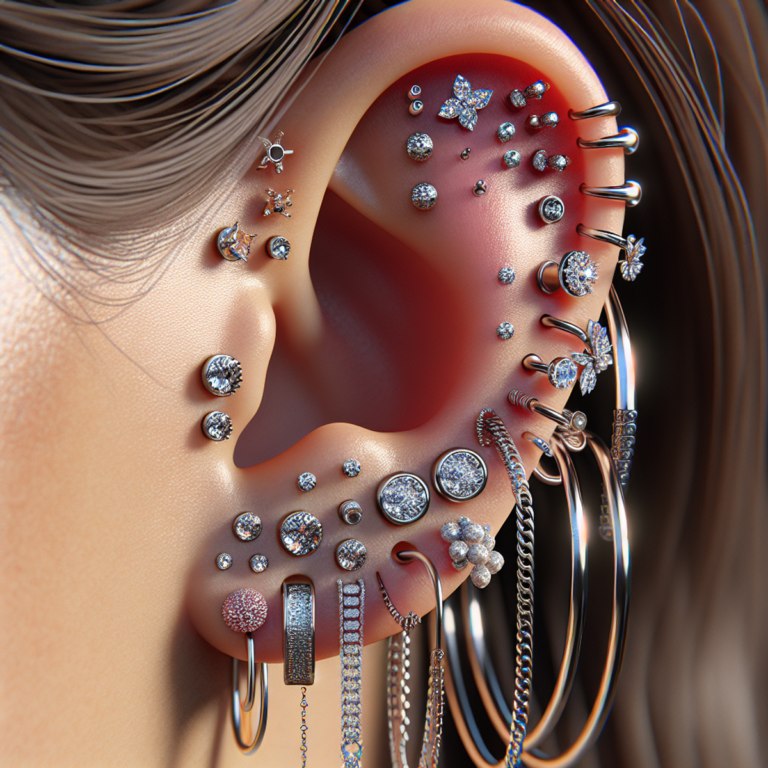Here’s How to Fix a Broken Nail and Save Your Manicure

Introduction
Maintaining a flawless manicure is essential for many individuals as it contributes to an overall polished appearance. A broken nail can easily detract from the elegance of a manicure and affect one’s confidence.
In this article, you will discover practical and effective methods to fix a broken nail at home, ensuring that you can easily restore the beauty of your nails with simple DIY techniques. Whether you’re dealing with a vertical split or a horizontal tear, these solutions will help you salvage your manicure and maintain impeccable nails.
Let’s explore how to address this common beauty emergency and empower yourself with the skills to keep your nails looking fabulous.
Understanding the Problem: Common Causes and Types of Broken Nails
When it comes to maintaining a flawless manicure, broken nails can be quite frustrating. Not only do they affect the overall appearance of your hands, but they can also be painful and inconvenient. In order to effectively fix a broken nail, it’s important to understand the common causes and types of nail breaks.
Causes of Broken Nails
There are several reasons why nails may break or become damaged:
- Trauma: Accidents or injuries can cause nails to break. Bumping your nails against hard surfaces or getting caught in something can lead to cracks, splits, or tears.
- Weak Nail Structure: Some people naturally have weaker nails that are prone to breaking. This can be due to genetics or certain medical conditions. Additionally, frequent exposure to harsh chemicals or excessive moisture can weaken the nails over time.
- Improper Nail Care: Neglecting proper nail care practices can contribute to nail breakage. Failing to keep the nails properly trimmed and moisturized can make them more vulnerable to damage. Certain vitamin and nutritional deficiencies have also been linked to weakened nails[^3^].
Types of Broken Nails
Nail breaks can occur in various forms, each requiring a specific approach for repair:
- Vertical Splits: These are cracks that run from the tip of the nail towards the cuticle. They are often caused by trauma or weak nails[^4^]. Vertical splits can be quite painful and may catch on objects easily.
- Horizontal Tears: Also known as stress fractures, horizontal tears occur across the width of the nail plate. They are often caused by trauma or repetitive stress on the nails, such as frequent typing or playing musical instruments.
- Complete Nail Avulsion: This refers to the complete tearing off of the nail from its bed[^2^]. It usually occurs as a result of severe trauma or injury and requires immediate medical attention.
Understanding the causes and types of broken nails is crucial because it helps determine the most appropriate method for repair. For example, vertical splits may require a different approach compared to horizontal tears. By identifying the underlying cause and type of break, you can effectively address the issue and prevent further damage. In some cases, addressing nutritional deficiencies that contribute to weakened nails can also be beneficial[^3^].
Step-by-Step Guide: How to Fix a Broken Nail Using a Tea Bag
The tea bag method is a popular and effective technique for repairing broken nails. It involves reinforcing the crack or break with a small piece of a tea bag, creating a temporary but strong patch that allows you to maintain your manicure. Follow these steps to fix your broken nail using the tea bag method:
Step 1: Gather the necessary materials
Before you begin, make sure you have the following items on hand:
- A tea bag (preferably unflavored and without any additives)
- Clear nail polish or base coat
- Scissors
- Nail file
- Nail buffer (optional)
Step 2: Prepare the damaged nail for treatment
To ensure proper adhesion and longevity of the repair, it’s important to prepare the damaged nail before applying the tea bag. Here’s how:
- Remove any existing polish from the affected nail using a non-acetone nail polish remover. This will help create a clean surface for better adhesion.
- Shape the edges of the broken nail with a nail file. Gently file any rough edges or snags to prevent further damage or snagging on fabric.
- If desired, use a nail buffer to smooth out any ridges or unevenness on the surface of the nail.
Step 3: Apply the tea bag patch
Now it’s time to apply the tea bag patch to reinforce and repair your broken nail. Follow these steps:
- Cut a small piece from the tea bag that is slightly larger than the size of your break or crack. Make sure it is large enough to cover the entire damaged area.
- Apply a thin layer of clear nail polish or base coat directly onto the broken area of your nail.
- Place the cut piece of tea bag over the wet polish, aligning it with your natural nail shape. Gently press down to ensure it adheres to the nail and smooth out any wrinkles or bubbles.
- Allow the nail polish to dry completely. You can use a fan or blow on your nails gently to speed up the drying process.
- Once dry, apply another layer of clear nail polish or base coat over the tea bag patch. This will further strengthen and seal the repair.
- Let the second layer of polish dry completely.
Step 4: Finish and maintain for long-lasting results
To ensure that your repaired nail lasts as long as possible, follow these finishing techniques:
- Trim any excess tea bag material that extends beyond the edge of your nail using scissors or nail clippers.
- Gently file the edges of your nail to blend the repaired area with the rest of your nail bed for a smooth finish.
- Apply one or two coats of your favorite colored nail polish over the repaired nail to complete your manicure. This will help camouflage any imperfections and provide extra protection.
Common mistakes to avoid when using the tea bag method
While the tea bag method is a great solution for repairing broken nails, there are some common mistakes to avoid:
- Using too large or too small of a piece of tea bag material. It’s important to cut a piece that is just slightly larger than the damaged area to ensure proper coverage and adhesion.
- Applying too much pressure when pressing down on the tea bag. Be gentle yet firm to avoid damaging the delicate patch.
- Skipping the step of applying a second layer of clear polish over the tea bag patch. This additional layer helps seal and protect the repair.
Alternative approaches using household items
If you don’t have a tea bag on hand, you can still repair your broken nail using other household items such as fabric or paper. Here’s how:
- Cut a small piece from an old clean fabric (like pantyhose) or a piece of paper.
- Follow the same steps as outlined above for applying the tea bag patch, replacing the tea bag with your chosen material.
It’s important to note that while these alternative approaches can provide temporary fixes, they may not be as durable or long-lasting as the tea bag method. Consider using them as a temporary solution until you can properly repair your nail with a tea bag or seek professional assistance if needed.
Exploring Other DIY Solutions for Broken Nails
When it comes to fixing a broken nail, the tea bag method may not always be the best solution. Depending on the type of nail damage or personal preference, you may want to explore alternative DIY methods. Here are two popular techniques you can try:
1. Toothpick and Nail Glue Method
This method is a simple and effective way to mend a broken nail. Here’s how you can do it:
- Start by cleaning your nails and removing any nail polish or debris.
- Cut a small piece of a toothpick that matches the length and width of the crack in your nail.
- Apply a small amount of clear nail glue directly onto the crack.
- Gently press the toothpick piece onto the glue, making sure it covers the entire crack.
- Allow the glue to dry completely.
- Trim off any excess toothpick that extends beyond your nail.
- Apply a layer of clear nail polish over the repaired area to seal and protect it.
2. Silk Wrap Technique
If you have more extensive nail damage or prefer a sturdier solution, you can consider using silk wraps. However, keep in mind that this technique may require more skill and practice. It’s best to seek professional assistance if you’re unsure about doing it yourself. Here’s an overview of how silk wraps can be used for nail repairs:
- Clean and prep your nails by removing any polish and gently buffing them.
- Cut a piece of silk wrap slightly larger than the size of your cracked or torn nail.
- Apply a thin layer of clear base coat onto your damaged nail.
- While the base coat is still wet, place the silk wrap over the damaged area and gently press it down.
- Trim off any excess silk wrap that extends beyond your nail.
- Apply another layer of clear base coat over the silk wrap to secure it in place.
- Allow the base coat to dry completely, then proceed with your regular nail polish application.
Remember, if you’re unsure about using these DIY methods or if you have severe nail damage, it’s always best to consult a professional manicurist. They have the expertise to assess your nails and provide appropriate solutions for repair.
Prevention and Maintenance Tips for Strong, Healthy Nails
When it comes to maintaining a flawless manicure, preventing nail breaks and promoting the overall strength and health of your nails is essential. By incorporating simple yet effective practices into your nail care routine, you can minimize the risk of breakage and ensure that your nails remain resilient and beautiful.
Emphasizing Ongoing Nail Care
To prevent future issues like nail breakage, it’s crucial to prioritize ongoing nail care. Here are some valuable tips to help you maintain strong and healthy nails:
- Keeping Nails Trimmed to the Right Length: Regularly trimming your nails to an appropriate length can help prevent them from becoming snagged or damaged. Be sure to use sharp, high-quality nail clippers for a clean and even cut.
- Wearing Gloves for Protection During Activities: When engaging in activities that involve exposure to water, harsh chemicals, or physical impact, such as dishwashing or gardening, consider wearing protective gloves. This can safeguard your nails from potential damage and maintain their strength.
- Maintaining Optimal Nail Hydration: Proper hydration is key to nail health. Apply a nourishing cuticle oil or moisturizing cream regularly to keep your nails and surrounding skin hydrated. This can help prevent dryness and brittleness, reducing the likelihood of nail breakage.
- Nourishing Nails with a Balanced Diet: A well-rounded diet rich in essential nutrients can significantly contribute to the strength and resilience of your nails. Incorporate foods high in biotin, protein, vitamins A and C, iron, and omega-3 fatty acids into your meals to promote overall nail health.
By integrating these preventive measures into your regular nail care routine, you can actively work towards maintaining strong, healthy nails that are less prone to breakage.
The Role of Diet and Nutrition in Nail Health
Proper nutrition plays a vital role in maintaining healthy nails. By nourishing your body with essential vitamins and minerals, you can promote strong and resilient nails. Here’s how a nutrient-rich diet can contribute to the health of your nails:
Key Vitamins and Minerals for Nail Health
- Biotin: Biotin, also known as vitamin B7, is often associated with hair and nail health. It helps strengthen brittle nails and promotes their growth. You can find biotin in foods like eggs, nuts, seeds, salmon, and sweet potatoes.
- Vitamin E: Vitamin E is an antioxidant that protects your nail cells from damage caused by free radicals. It also improves blood circulation to the nail bed, promoting healthy nail growth. Good sources of vitamin E include almonds, spinach, sunflower seeds, and avocados.
- Iron: Iron deficiency can lead to brittle nails and slow nail growth. Including iron-rich foods like lean meats, beans, leafy greens, and fortified cereals in your diet can help maintain optimal iron levels for healthy nails.
- Zinc: Zinc is essential for protein synthesis, which is important for nail strength and growth. Foods rich in zinc include oysters, beef, pumpkin seeds, chickpeas, and cashews.
- Omega-3 Fatty Acids: Omega-3 fatty acids help moisturize the nails from within, preventing them from becoming dry and brittle. Incorporate foods like fatty fish (salmon, mackerel), flaxseeds, chia seeds, and walnuts into your diet to boost your omega-3 intake.
Tips for Incorporating Nail-Healthy Foods into Your Diet
To ensure you’re getting the necessary nutrients for strong and healthy nails:
- Include a variety of fruits and vegetables in your meals to provide a wide range of vitamins and minerals.
- Incorporate lean proteins like chicken, fish, tofu, or legumes into your diet for biotin and amino acids.
- Snack on nuts and seeds for a dose of zinc and vitamin E.
- Choose whole grains like quinoa, brown rice, and oats to support overall nail health.
- Stay hydrated by drinking plenty of water throughout the day to maintain optimal nail hydration.
Remember that dietary changes take time to show results in your nails. Be patient and consistent with your healthy eating habits, and you’ll gradually notice improvements in the strength and appearance of your nails.
Note: While a nutrient-rich diet is beneficial for nail health, it’s important to consult with a healthcare professional if you have specific nutritional concerns or underlying medical conditions that may affect your nails.
By focusing on proper nutrition and providing your body with the essential building blocks for healthy nails, you can enhance the overall condition of your manicure.
When to Seek Professional Help for Nail Injuries
It’s important to know when a broken nail requires professional attention. While many nail injuries can be fixed at home, there are certain situations where medical intervention is necessary. Here are some signs that indicate you should seek medical help for severe nail damage:
- Excessive Bleeding or Persistent Pain: If your broken nail is causing excessive bleeding or if you experience persistent pain, it’s a clear indication that you should consult a healthcare professional. Excessive bleeding could be a sign of underlying damage to the nail bed or surrounding tissues, and persistent pain may indicate a more serious injury.
- Signs of Infection, such as Redness or Pus Formation: If you notice any signs of infection around the broken nail, such as redness, swelling, or pus formation, it’s crucial to seek medical attention. Infections can occur when bacteria enter through the broken nail and can lead to complications if left untreated. A healthcare professional will be able to assess the severity of the infection and provide appropriate treatment.
- Complete Nail Avulsion (Nail Being Completely Torn Off): If your nail has been completely torn off, it’s essential to seek immediate medical help. This is considered a severe injury and may require specialized care to prevent complications and promote proper healing. A healthcare professional will be able to assess the extent of the injury and provide appropriate treatment options.
Remember, these guidelines are for severe nail injuries that require medical attention. For minor breaks and tears, the DIY methods discussed earlier in this article can be effective in repairing the nail at home. However, if you experience any of the above signs indicating a need for medical intervention, it’s important not to delay seeking professional help.
By being aware of when to seek professional assistance for severe nail injuries, you can ensure that your nails receive the appropriate care they need. It’s always better to be cautious and consult a healthcare professional if you’re unsure about the severity of your nail injury.
Conclusion
It’s important to keep your nails well-groomed and fix any broken nails quickly to maintain a perfect manicure. Here are some key takeaways from this article:
- Remember, taking care of your nails is essential for a polished and put-together appearance.
- By promptly addressing broken nails, you can maintain a flawless manicure and boost your confidence.
- The DIY methods shared in this article provide practical solutions that anyone can master with a bit of practice.
So go ahead and give these techniques a try! With consistent nail care and the knowledge gained from this guide, you’ll be able to handle nail emergencies like a pro and enjoy beautiful, healthy nails in the long run.









